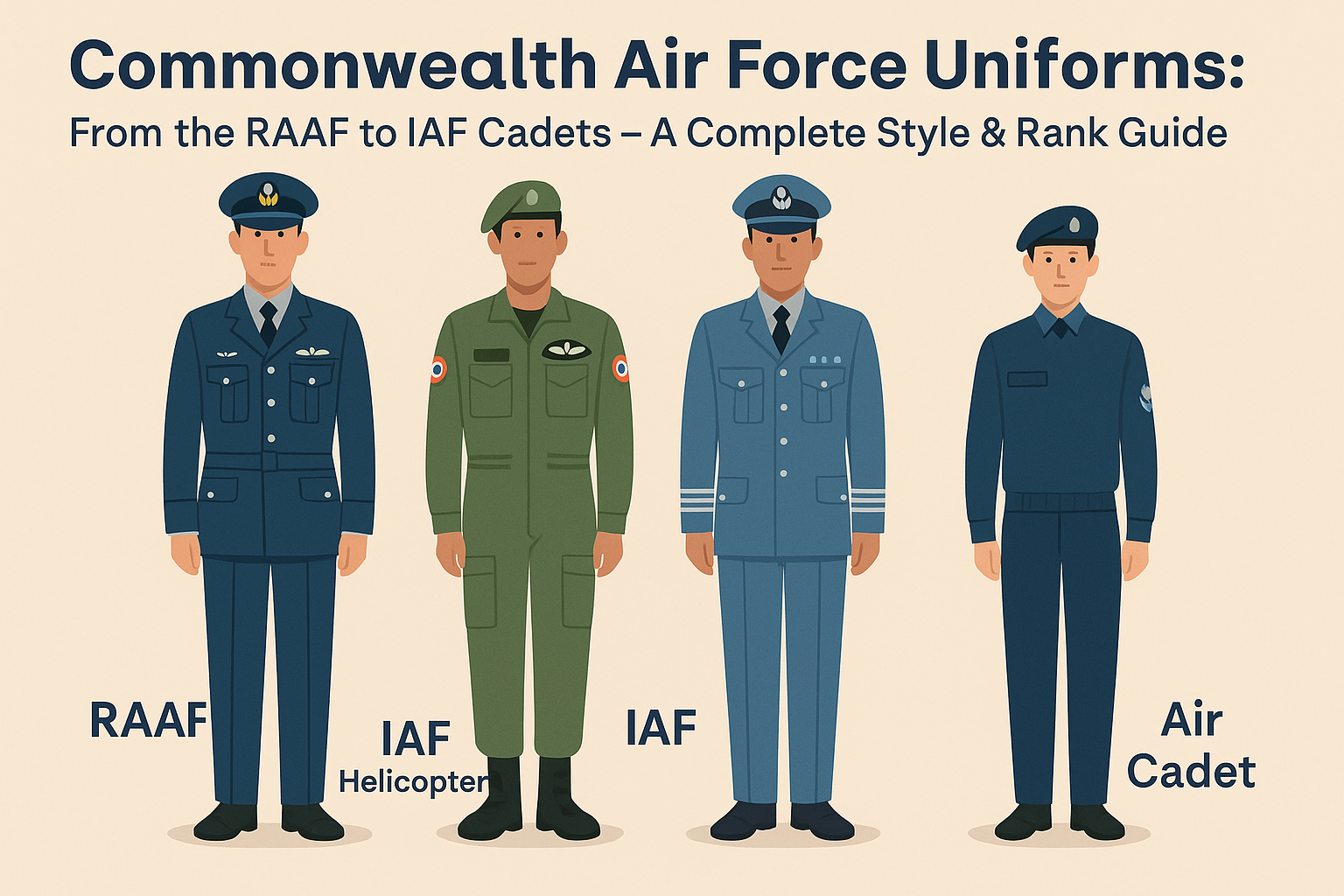
Commonwealth Air Force Uniforms: From the RAAF to IAF Cadets – A Complete Style & Rank Guide
Published on Jun 16, 2025
1. Understanding Commonwealth Air Force Uniforms
The Commonwealth's air forces—such as those of Australia, India, and Canada—share a historical link with the British Royal Air Force. Over time, each nation has adapted its uniforms to suit regional needs while retaining core design elements rooted in tradition, professionalism, and identity.
2. Royal Australian Air Force (RAAF) Uniforms
Dress Uniform (Ceremonial & Service Use)
- Colour: Classic slate blue with a tailored fit.
- Components: Tunic, trousers or skirt, white shirt, black tie, and peaked cap.
- Insignia: Metallic pilot wings and rank stripes on epaulettes or sleeves.
- Footwear: Glossed black leather shoes or ankle boots.
Operational Uniform
- For pilots and ground crew, the RAAF utilizes practical flight suits made from flame-resistant fabric, often in olive or blue tones.
- Modern gear includes patches for squadron identification and mission wings.
Fun Fact: The RAAF was the second air force formed independently, right after the RAF in 1921.
3. Indian Air Force (IAF) Uniforms: Helicopters, Ranks, and More
IAF Helicopter Crew Gear
- Flight suits: Olive green, multi-pocket, utility-based designs.
- Special features: Fire-resistant materials, zippered compartments, helmet compatibility.
- Used by Transport crews, attack helicopter pilots, and search-and-rescue teams.
Ranks in the Indian Air Force
Officer RankInsignia Description
Flying Officer One stripe
Squadron Leader Three stripes
Air Commodore One thick + one thin stripe
Air Chief Marshal Four stripes, including one thick
Airman RankInsignia Description
Leading Aircraftsman Propeller symbol
Corporal Two chevrons
Sergeant Three chevrons
Warrant Officer National emblem badge
Rank badges, which appear on shoulder straps or arms, denote authority, training level, and specialization.
4. Air Cadets Uniform: Training the Next Generation
Air Cadet programs across Commonwealth nations use uniforms that foster discipline and pride, preparing young recruits for potential careers in aviation or military service.
Components of the Air Cadets Uniform:
- Shirt/Jumper: Blue long-sleeve button-up with embroidered name tags.
- Trousers/Skirt: Matching blue, often wool-blend.
- Rank Markings: Cadet NCOs use silver or white chevrons on sleeves.
- Beret/Cap: Standard with cadet force insignia.
- Shoes: Shined black military-grade footwear.
In the Indian Air Training Corps, cadets may also receive specialized badges after completing camps, glider flights, or leadership roles.
5. Key Differences Between RAAF and IAF Uniforms
FeatureRAAFIAF
Main Uniform Color Slate Blue Sky Blue / Olive
Ceremonial Style British-influenced Mix of British & Indian
Pilot Gear Flight suits, blue/grey Green/olive jumpsuits
Cadet Uniforms Standard ATC Blue NCC-style uniforms
Rank Insignia Placement Shoulders, sleeves Shoulders, collar, sleeves
Despite sharing roots, each force has a distinct visual identity and functionality in its uniforms.
6. Why Uniforms Matter in the Air Force
- Hierarchy: Rank structure is immediately visible, maintaining order in high-pressure environments.
- Safety & Utility: Operational gear protects from fire, weather, and other hazards.
- Symbolism: Uniforms build cohesion and national pride.
7. Collecting and Preserving Air Force Uniforms
Interested in collecting authentic or reproduction Air Force uniforms? Here are tips:
- Authenticity: Look for tags with official markings, date stamps, and original buttons.
- Condition: Original WWII and Cold War pieces should be stored in breathable bags away from direct light.
- Reproductions: Great for reenactments or display, especially through niche sites like Paddelaters.com.
8. Common Questions Answered
Q: Do air cadet uniforms differ by country?
Yes, while all three reflect military-style discipline, Australia, India, and the UK have tailored designs that suit their respective training programs and climates.
Q: Can civilians wear RAAF or IAF uniforms?
Reproduction of uniforms for theatrical or educational purposes is typically permitted—but impersonating active personnel is strictly prohibited.
Q: How often are flight suits updated?
Regularly. As new technologies and fabric standards evolve, air forces upgrade their suits to improve pilot safety and mission readiness.
Final Thoughts
The uniforms of the Commonwealth Air Force—whether the polished blues of the RAAF or the tactical gear of IAF helicopter crews—serve a deeper purpose than appearance. They embody service, structure, and tradition. Air cadet programs also offer young people the opportunity to wear uniforms that signify their future readiness and a commitment to excellence.
